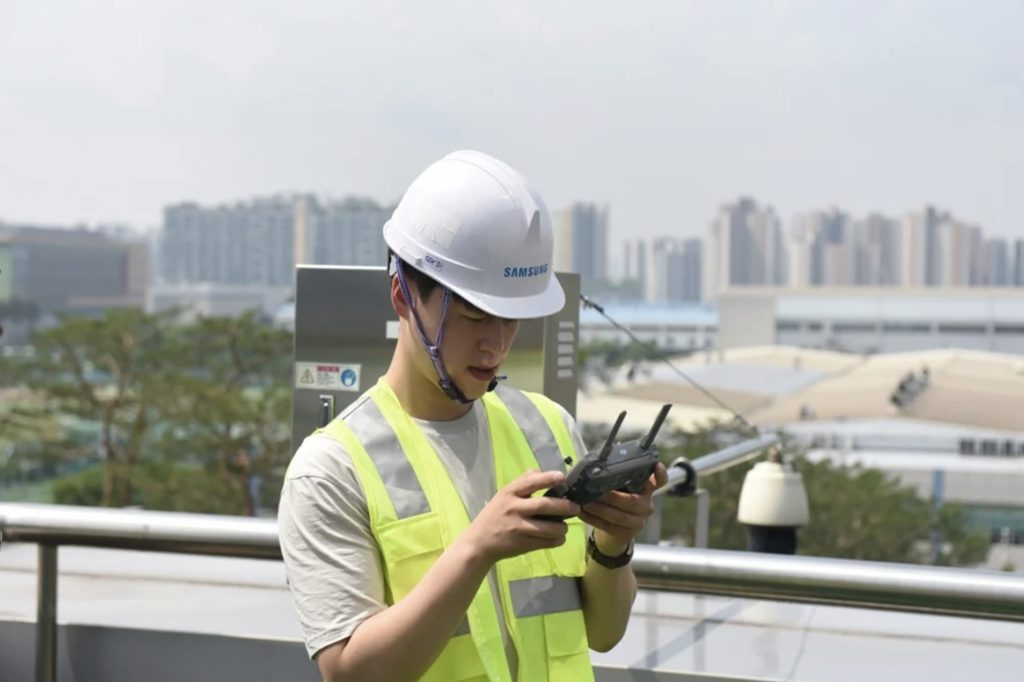
Samsung Electronics today announced its successful demonstration of a drone-based antenna configuration measurement solution for 4G and 5G networks in the company’s Seoul, South Korea campus.
This drone automated solution will give operators a simplified way to efficiently manage cell sites, improve operators’ safety, and ultimately optimise local 4G and 5G network performance.
Sohyong Chong, Vice President and Head of Network Automation, Networks Business at Samsung Electronics explained what the drone automated solution meant by saying: “As the number of 5G network sites grows, there has been a heightened focus on network performance by operators, and we are seeing an increased market demand for intelligent solutions for site maintenance. Once this solution launches globally later this year, it will offer a safer, more cost-effective, and convenient way to satisfy market demands, leveraging our unique capabilities in combining the latest technologies—drones, AI, and 5G.”
In the demonstration, an engineer on the ground used a smartphone with a remote control application to fly a camera-equipped drone that captured photos of the antennas installed on a building’s rooftop.
The visual data was viewable via the engineer’s smartphone and then was transmitted to a cloud server within seconds making for easy viewing and quicker analysis.
The deep learning-based artificial intelligence (AI) solution instantly verified the rotation and tilt of the antennas, so that the engineers could determine if the antennas were installed correctly at predefined optimal angles.
It took less than a minute to transmit the data and process the results, enabling the engineer to view results on-site in real-time on the smartphone screen. The demonstration verified that Samsung’s drone solution can accomplish the task within 15 minutes – starting from flying the drone to the delivery of measurement results.
This solution significantly cuts the time needed to carry out the task of antenna configuration measurement with a standard procedure taking up to several hours to complete when you account for safety permissions to go up the tower, get down the tower, and then do the analysis.
In conjunction with this new solution, Samsung said that it will continue to add features and enhance capabilities, which include allowing the engineers to remotely adjust the antenna tilts to its optimal position from a mobile device and PC.

This demonstration announcement comes at a time where drones are becoming increasingly popular with the wireless drone and robot charging solutions provider WiBotic raising $5.7m to handle the increased business and consumer demands of drones and their increasing capabilities.
5G is becoming increasingly used due to its expanded use in commercial and personal use which include fields and industries such as education, VR/AR, autonomous vehicles, healthcare, smart logistics, and smart connected factories increasingly using robotics.
Cellular antennas are typically installed at significant heights on sites such as cell towers or rooftops, in order to ensure optimal device coverage.
Operator field engineers ordinarily carry heavy and expensive equipment as they climb up cell sites to measure the antenna configurations. With Samsung’s drone-based antenna configuration and AI solution, operators will have a new approach for reinforcing the safety of their team and freeing up time and resources for other tasks making the business more efficient.
The drone-based antenna configuration solution’s safety benefits will be especially helpful during site audit and maintenance in the U.S. The reason being is they often require two field personnel to be dispatched to a site to audit or adjust the antenna angles and requires climbs that use more advanced safety training.
Samsung plan to launch the drone-based antenna configuration solution globally at some point in 2020 to assist in upgrading existing 4G network towers with the new 5G capabilities.




One Comment